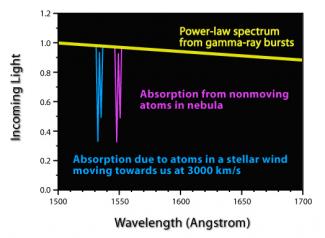There’s a new aspect to research on gamma-ray bursts: their use to discern features of the environment around the star that produced them during its core’s collapse into a black hole. This type of analysis is possible because the spectrum of a gamma-ray burst afterglow is a straight-line continuum without features. Absorption lines can appear in the spectrum because of the interaction of optical and X-ray photons with the surroundings of the supernova. The absorption lines shown at right carry information regarding the chemical composition of structures around the dying star as well as their motion, speed, and direction.
In the past year, senior research associate Davide Lazzati collaborated with two research teams to investigate the environments around two recently observed gamma-ray bursts. Lazzati and colleagues from the Netherlands’ Kapteyn Astronomical Institute and Italy’s Osservatorio Astronomico di Brera, Instituto di Astrofisica Spaziale e Fisica Cosmica, and Università degli Studi di Milano-Bicocca found a metal-rich cloud (nebula) surrounding a gamma-ray burst that occurred when the Universe was only a billion years old. The nebula was close to the dying star when the star exploded, emitting the gamma-ray burst. It was also relatively stationary. It probably resembled nebulas we observe today, including the Orion Nebula, shown here.
The finding of the metal-rich cloud supported a theoretical prediction that the Universe’s first supermassive stars had already gone supernova, creating heavy elements in the process and spewing them into the young Universe. Thus even at such an early age, the Universe already contained the ingredients needed to create a Sun and planets like ours. “The ingredients were out there,” Lazzati said, adding the caveat that “having flour and salt doesn’t mean you’ve got pasta.” He noted that the nebula was rich in silicate grains, which make up the quartz that is abundant in Earth rocks.
In a study of an environment around a gamma-ray burst that exploded when the Universe was three billion years old, Lazzati worked with Fellow Rosalba Perna; Joseph Flasher, who received his M.S. from CU in November 2005; and colleagues from the University of Chicago and the Osservatorio Astronomico di Roma. This group discovered a formidable stellar wind very far away from the gamma-ray burst and moving away (towards Earth) at more than 3000 km/s. The researchers deduced that the carbon-rich wind had originated in a star 100 times as massive as the Sun about 100,000 years before it went supernova. The gamma-ray burst accompanying that explosion allowed the researchers to “see” the ferocious wind, thought to resemble the turbulent and clumpy stellar winds shown above that are produced in Nebula M1-67 around a massive Wolf-Rayet star. - Julie Phillips




